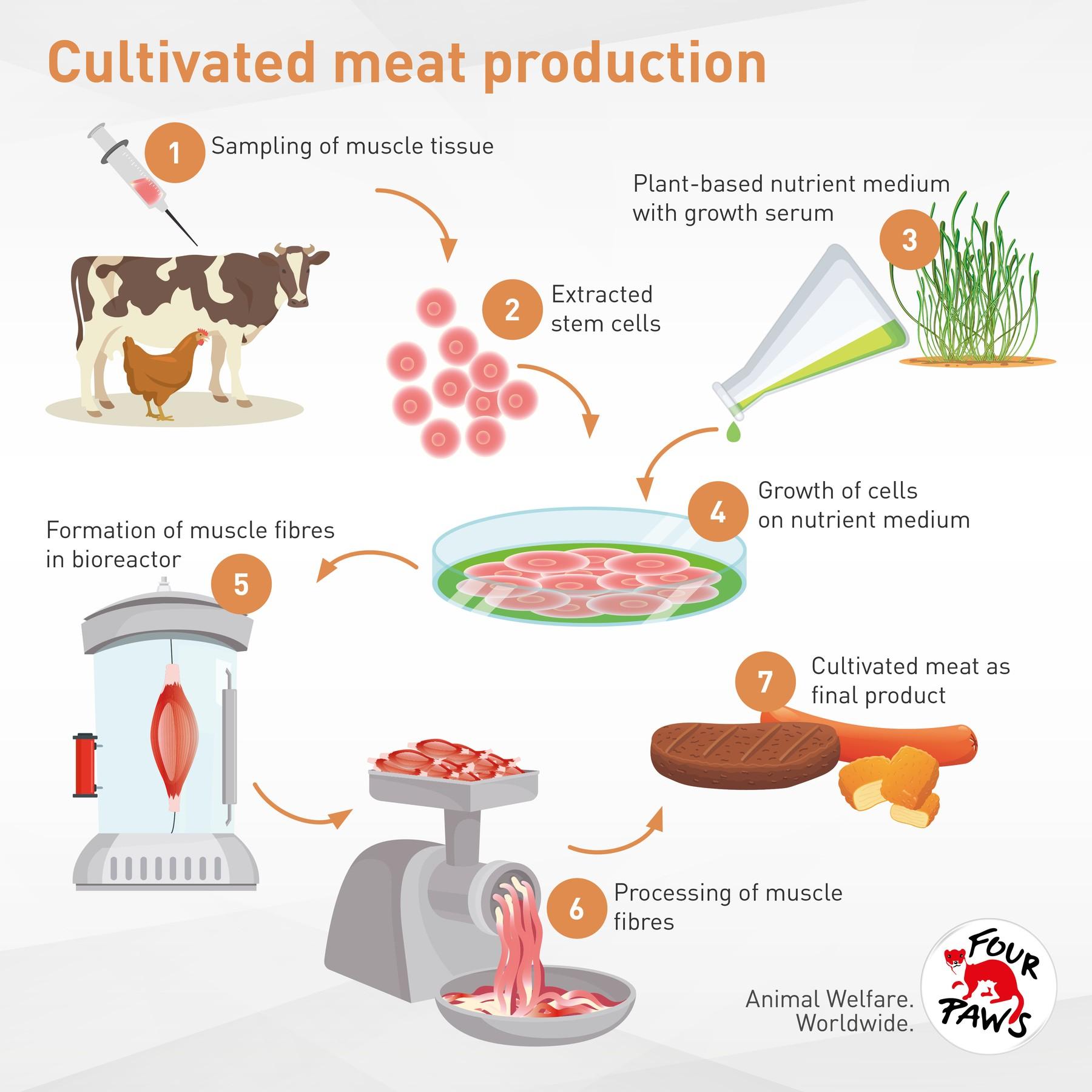
The Clean Future of Meat
Meat Production Without Killing Animals: What You Need To Know
The current production of animal products subjects billions of thinking, feeling animals to live in extreme confinement. In these situations, these innocent animals experience trauma, mutilations and painful slaughter.
If there was a way to create meat which looked, tasted and cooked just like the "real thing" and came from a live animal who didn’t need to be exposed to cruel keeping systems or slaughter, would the public be open to it?
What would it be called?
There are a handful of start-ups focusing on creating meat that doesn’t involve suffering or death. Cultured, or lab-grown meat (commonly referred to as “clean meat,) is a groundbreaking technology set to revolutionize the global food system.
According to the Good Food Institute, “clean meat” is a more accurate term that describing real meat grown without animal slaughter.
Clean meat is similar to “clean energy” in that it immediately communicates important aspects of the technology—both the environmental benefits and the decrease in food-borne pathogens and drug residues.
It’s no more accurate to say that clean meat is “lab grown” than it is to say that Cheerios and commercial peanut butter are “lab created.” All processed foods start in a food laboratory, of course, but with clean meat, the end result is real meat and no animal suffering.
One such start-up is a Dutch company called Mosa Meat, co-founded by researcher at the University of Maastricht, Dr. Mark Post. Dr. Post, known as the ‘father of Clean meat,’ was the first person to bring clean meat to the public’s attention in London in 2013. His three main motivations for developing Clean meat are:
- Food security
- The environment
- Animal welfare
What exactly is clean meat?
Rather than obtaining meat from animals raised on environmentally destructive factory farms where the animal is treated as a commodity instead of a sentient being, clean meat is produced by taking a small sample of stem cells- usually from lean muscle- through a harmless procedure. It is similar to the way blood is drawn. These cells are then replicated in a culture outside of the animal.
After sufficient cells have grown, they are assembled in groups to form small muscle tissue that are very similar to muscle fibers in a steak. The resulting product is 100% real meat.
It is known that the binding serum used in this technology would be taken from fetal bovines, however Dr. Post states this is no longer necessary. “There are a number of pressuring reasons to eliminate bovine serum. It is inherently unsustainable, and obtaining serum from unborn calves is incompatible with our animal welfare standards. It is also a disease risk.”
Dr. Post's company is working on optimizing the binding agents with plant based serums instead.
Clean meat can be made from any animal that has muscle specific stem cells in muscles. This means all the common animals used for food, such as mammals, birds and fish.
Why is Mosa Meat only focusing on beef?
“We are focusing on beef because cattle are the least efficient links in food production. Their conversion rate is 15% or lower, meaning that you need to feed cattle 1kg of feed to get 150 grams of muscle out of it. Pigs are twice as efficient and chicken is even four times as efficient. Fish is the most efficient. For animal welfare reasons, replacing pigs and chickens with cultured meat variants is a very good idea,” says Dr Post.

Cultivated meat vs. factory farming
'Cultivated Meat' can theoretically be made from any type of animal cells (e.g. cows, chickens, pigs, fish). Looking at the amount of meat being produced worldwide and the continuous rise in consumption of animal-based products, cultivated meat could potentially reduce the numbers of animals being farmed for food and thus the need for factory farming. On top of that, the environmental and climate impact of animal agriculture and particularly factory farming could be reduced drastically.
| Status Quo (May 2025) | Cultivated Meat | Factory Farming |
| Animal Welfare | No breeding and slaughter; no intensive husbandry; no transport; reduces the need for factory farming (from an animal welfare perspective, high animal welfare standards for donor animals must be ensured) | Animal-cruelty, slaughter, animals being adapted to husbandry system; long transport of animals across countries |
| Environmental impact | Less energy and water use (depending on the production method, energy source and produced product); less land use (no feed crop agriculture) | High greenhouse gas emissions, land use (feeding + grazing), deforestation, pollution (manure), biodiversity loss |
| Health & Safety | Sterile production conditions; no need for antibiotics; enables control over fat content, nutrients, taste profiles etc. | High use of antibiotics and hormones; risk of pandemics and zoonotic diseases; limited control over composition and dependent on genetics |
| Consumer Acceptance | Still relatively unknown; diverse (varies by region e.g. it’s high in Asia, lower in EU and USA) | Widely accepted and normalised |
| Availability | Limited (available in Singapore, China, Israel) | across all countries |
| Challenges | High production costs; regulatory approvals (bans); scaling up to meet industrial level | Consequential costs caused by impact on environment, climate pandemics and animal diseases, food safety, human health and animal welfare not factored in |
Source
2. Good Food Institute, Bruce F. Cultivated meat: Why GFI is embracing new language. 2019 [accessed 2025 May 23]. https://gfi-india.org/cultivated-meat-why-gfi-is-embracing-new-language/

